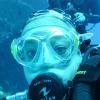I remember when I was growing up in the midwest some adults seemed to get moody during the winter. High snowdrifts and overcast days with only occasional sunshine are not good for the soul! That's one reason I moved to California from Chicago as soon as I possibly could. Of course back then we had no knowledge of seasonal affective disorder (SAD). We just referred to individuals suffering from it as "brooding."
We have a sea anemone that lives in our waters that is also referred to as brooding. Now a psychiatrist wouldn't have much interest in probing their moods, since they only have a simple nerve net and lack any semblance of a brain. This coelenterate (or cnidarian if you're of more recent upbringing) receives its common nickname from the fact that it broods its young. As far as I know, it is not subject to mood swings of any kind. However, in addition to sunny southern California, this species can be found all the way up to Alaska.
Although these anemones are said to be common on and under rocks as well as on algae and eelgrass from the middle intertidal to subtidal habitats, I just don't see them that frequently these days. Perhaps they have succumbed to the increased temperature in California waters attributed to global warming and shorter term thermal events. One unusual habitat I do find them on occasionally is the saddle of the stipe of our southern sea palm kelps. They are said to prefer areas with wave action, perhaps because it brings them food or keeps them moist. They do not tolerate exposure to air or sun.
These small anemones may measure two inches across their disk, but they have a broader base which they use to attach to the rocks. The short tentacles may number from 48 to 96. Although many of the individuals I have seen are reddish to orange, their color also may be green, brown, blue or gray. Brooding anemones may be solid in color or mottled.
So how did this apparently carefree coelenterate get such a depressing name? If you look closely, a quarter to half of the adults have much smaller juvenile anemones attached to their base or column. These tiny offspring were not formed by asexual budding. Instead they are produced through sexual reproduction, and they have a unique sex life for such simple critters.
Most of the population consists of young adults one quarter to just over half an inch in diameter. Almost all of them function as females at this stage. As these young females grow, male testes begin to develop alongside their ovaries. If they survive to a diameter just under one inch, they become simultaneous hermaphrodites. I know my readers are mentally sharp, and remember that this means they have both sex organs in their bodies functioning at the same time. So only the older individuals produce the sperm to fertilize the eggs of the younger females, as well as the more mature ones. They are also capable of fertilizing their own eggs, so these longer-lived individuals can pass on the traits to their offspring that have allowed them to survive the trials and tribulations of the life aquatic.
Brooding anemones have no defined breeding season. The eggs are fertilized inside the digestive tract and are expelled through the mouth. They then migrate to the column and base of the adult where they attach. A large parent may brood more than 30 young. Initially these "babies" survive on the yolk from their eggs, and receive no nourishment from the parent. Once they have developed their own tentacles they begin active feeding. After about three months, they migrate away from the parent and colonize adjacent areas on the rocks. This invertebrate is also known as the proliferating anemone since it can get pretty crowded in the immediate neighborhood of mom/dad. However, these anemones are capable of moving at breathtaking speeds... 3-4" per hour!
Since brooding does not involve a planktonic larval stage, these anemones don't have a life history form that can easily disperse to colonize new habitats. During my research at Toyon Bay in the 1960's and 1970's, I studied the marine life that could be transported on drifting giant kelp paddies or "rafts." The brooding anemone is known to attach to algae, and I did find them on these drifting rafts. Therefore it is quite possible they colonize new habitats by drifting on detached algae including giant kelp.
Biologists are not entirely certain what these sea anemones feed on. There aren't too many scientists who want to spend their lives in a laboratory studying brooding anemone stomach contents! It is assumed they feed on small crustaceans like copepods, amphipods, and shrimp; jellyfish and possibly very small fish. They capture their food using the stinging cells, or nematocysts, that are common to cnidarians. In turn, they are fed upon by nudibranchs, certain starfish and bony fish. Several of the nudibranch predators are able to ingest the stinging cells and incorporate into their own bodies for their defense. The anemones are also known to hitch rides on hermit crabs. This is an example of mutualism since the anemone may help protect the crab, and the crab may provide scraps of food for the anemone.
© 2008 Dr. Bill Bushing. Watch the "Dive Dry with Dr. Bill" underwater videos on Catalina Cable TV channel 49, 10:00 AM and 5:00 PM weekdays. My latest DVD on Sharks and Rays of Southern California is available now. Yes, take Dr. Bill home with you... we'll both be glad you did! For more information see my website http://www.starthrow...cts/dvd/DVD.htm or call 310-510-8436.
Image caption: Adult brooding anemones with juveniles attached to their base and column; saddle of a southern sea palm kelp.
























